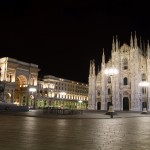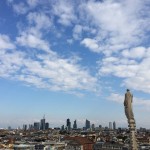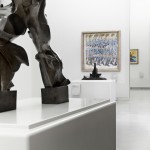Enjoy a night concert into the church (then go cycling with Critical Mass Milano!)
Milan: Duomo and Galleria
Iconic landmarks of the city
The famous Duomo of Milan will impresses you for its bulk… It is majestic! Gothic style, maybe one of the biggest Gothic cathedrals in Europe. In Italy there are no other examples, it is one of its kind. In order to get the true Gothic style you have to look at the apse on the back side, not just the front. Is the back side better? Yes it is, but tourists don’t know that!
The works for its construction started in 1386, and they started just from the apse. It took more than one century before starting the frontside, made in 1500s! The doors style reminds of Michelangelo, Renaissance, and the pointed arch doesn’t appear anymore here. Fun fact: we can still see the pointed arch on the frontside because Napoleon, who loved the Gothic style, wanted it to appear also ahead. He wanted to be crowned in the Duomo but the church wasn’t finished even for his coronation! Still today, works of building and restoration keep going…
The marble needed for the Duomo comes from Candoglia on Lake Maggiore: it is an exclusive marble, given by the Family Sforza for the Duomo at the end of 1400s. They carried it easily and quickly thanks to the stream of the lake, passing through the river Ticino and then through the Naviglio Grande. But why building such a big cathedral? In this case the answer is given by Galeazzo Visconti, a lord that wanted to exalt himself and his family.
The Gallery
The Gallery has just been renovated. Here I am in 1865: when it was built the Unification of Italy was just declared. The architect Mengoni proposed a part in a Renaissance-style and the upper one made of iron and glass. Even before the Eiffel Tower, Mengoni used iron in architecture. The idea of Mengoni is to celebrate the Unification of Italy and to give an image of markets, greenhouses and functional architectures.
There’s also the celebration of the King Vittorio Emanuele, to whom the whole gallery is dedicated, with the emblem of Turin, which has become a turistic attraction! Apparently it brings good luck if you step on bull’s testicles… Everyone does that, Koreans, Chineses, Indians… They don’t know that this bull is the emblem of Turin! It is hard to recognize the intimate parts to step on by now, there is a hole in there!
Today the gallery is full of important fashion brands like Gucci, Amrani, Vuitton, Versace… Just being there gives you prestige, but let’s remember what really meant the Gallery for Milaneses: it was the place where they were coming to take a coffee! Where now there are fashion stores, once there were a lot of cafés. The gallery was born to link the Theatre La Scala and the Cathedral. Each one of this historical cafés had its group of affectionates: intellectuals, politicians, singers that wanted to be famous.
⇒ Watch the full web serie Milan & Leonardo da Vinci
Cover pic courtesy of Flickr User Andrew and Annemarie
Video full text: Milan: Duomo and Galleria
On my bike I’ve arrived at Milan’s famous Cathedral,
which is impossible to miss, given its size… it is magnificent!
Are you looking at the Cathedral’s façade?
Yes, it is beautiful but you’ll need to go round the back to really see the Gothic work.
The best part is its rear?
Of course, but tourists don’t know this and no one goes there.
The original part is the apse!
The Cathedral’s first stone was laid in 1386, precisely in the area of the apse.
That’s where the construction work began, and we can only imagine the size of the construction.
The façade was finally built in 1500!
The doors on the ground floor have an almost Michelangelo type style,
but there’s no longer a lancet arch.
An interesting feature – the lancet arch returns higher up.That’s because Napoleon loved Gothic! It was he who had the façade completed.
Thank goodness… from this point of view Napoleon was right.
Napoleon was due to be crowned in the Cathedral,
but it wasn’t even finished in time for that.
Actually, it isn’t even finished now.
Building and restoration works are never ending!
Now, as it did in times gone by, the marble used for the Cathedral continues to arrive.
It’s marble that doesn’t come from Carrara but from Candoglia, on Lake Maggiore.
There’ll be no mountain left once the Cathedral is finished.
It’s an exclusive marble, donated by the Sforza family to the Veneranda Fabbrica del Duomo towards the end of the 15th century.
So how did they manage to transport that marble as far as here?
Using the waterways, this is the ingeniousness of the Milanese!
The marble reached Milan sedately, descending with the flow of the currents.
No need for propulsion.
From Lake Maggiore to the Ticino river and then on to the large canal, known as the Naviglio Grande.
The Naviglio would then enter into the internal pit and the marble would be unloaded back here.
They worked here, in a massive construction site, behind the Cathedral.
In Milan there is a road that still bears the name via Laghetto (small lake street).
That was the location of the small dock where the marble was unloaded,
and where they began working on it immediately.
A lot has been said about the construction of Gothic cathedrals.
But why make such things?
There was one man behind it all, Galeazzo Visconti.
He also wanted to bring glory upon himself and his own family lineage.
For Milan a Gothic structure from beyond the Alps is something a little odd.
There aren’t any in Italy, it’s unique.
And what did our Leonardo have to say about the Cathedral?
Leonardo stole some papers from the Fabbrica del Duomo,
some of his drawings bear the “Fabbrica del Duomo” mark!
Yes, of course, paper was expensive.
I’m growing increasingly more fond of Leonardo!
They consulted him for the construction of the crossing tower, he did a small drawing!
A sketch on how to solve the technical issues associated with the construction of the cupola.
Where are you taking me now?
Let’s take a stroll through the Galleria, it’s just been renovated.
We’re travelling back in time, to 1865,
to the time when it was built and the unification of Italy had just been proclaimed.
The architect, Mengoni, suggested a part of it should be in Neo-Renaissance style,
whilst the upper part should be in iron and glass.
This was the time of the Eiffel Tower when iron was being used in architecture.
Mengoni’s ingenuity was the idea of celebrating the unity of Italy
along with a solution that was that of market places, glasshouses and functional architecture.
This is the celebration of King Victor Emmanuel, after whom the entire Galleria is named:
the Savoy coat of arms.
There’s another coat of arms, that of Turin, which has become a tourist attraction!
They come from all over the world to do it, Koreans, Chinese, Indians.
I get annoyed with the tourists, I tell them off, it just seems a little trite.
And they don’t even know that it’s Turin’s coat of arms.
It would seem that spinning around three times with a foot on the bull’s private parts brings good luck.
Who knows, I’ll give it a go as well.
A hole has appeared over the bull’s testicles, everybody stamps on them!
Perhaps I haven’t stamped enough.
The Galleria is now filled with famous brand names and fashion.
They’re all here, Gucci, Armani, Vuitton and Versace.
Being there brings with it a considerable prestige, but there are those that have always been there.
Fratelli Prada, the historic store that used to sell suitcases.
This shop, with its English furnishing, dates from the early 1900s,
when Prada was not yet the Prada that we know today.
Let’s remind ourselves of what the Galleria really was for the residents of Milan:
it was the place to come to the café!
Now there are lots of fashion stores, once there were many café’s.
It was created as a way of connecting La Scala to the Cathedral.
We’re standing outside the famous Savini restaurant,
each of these establishments had its own groups: intellectuals, politicians,
and singers, who would come here to be heard and to get some work.
This was a place for living and a life of culture, a salon.
As can be seen in the painting by the famous futurist painter, Boccioni, dating from the early 1900s.
It depicts the Galleria with the people parading, in their smart clothes and their large hats.
I have an appointment to meet Massimiliano Taveggia for a coffee.
He knows how to interpret the innermost soul of Milan,
right here in the Galleria, in the famous Camparino café.
Perhaps now’s not the right time for a Camparino, so we’ll have a coffee instead.
I’d like a macchiatone (an espresso with a dash of milk)! He replies yes.
There are now so many different ways to ask for a coffee.
I ask for it with no spoon because I don’t take sugar anyway.
This is a historic place where intellectuals and painters used to gather.
It was opened by Gaspare Campari when the Galleria was inaugurated in 1867.
That was the moment when the idea for the aperitif was born and the establishment was named Camparino.
The idea that one could whet one’s appetite before an evening meal
has remained a typically Milanese ritual, perhaps even the city’s trademark.
Milan is constant invention, with an ability to always know how to redesign itself.
Even the panettone (sweet bread) has been revamped.
It’s now available all year round because it’s been deseasonalised.
The official store that also sells products with the Milan trademark sells panettone too.
Perfect for a snack.
Babas are eaten all year round, so why not panettone?
After my snack I leave the Galleria and enter Piazza della Scala,
where I find the monument to Leonardo Da Vinci.
We’ll come across him almost everywhere in Milan; he will become the object of a “treasure hunt”.
Because Milan is Leonardo and Leonardo is everywhere in Milan.
You just need to know where to find him!














